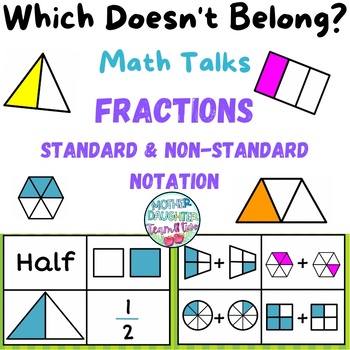Which Doesn't Belong - ALL FRACTIONS. Math Talks, Math Centers, Math Handouts
- PDF
- Easel Activity
Also included in
- ***** INCLUDES GOOGLE SLIDES FORMAT as well as PDF*****No Prep! Great for in person learning and digital classes! NOW 6 products in 1 provides you with more than 320 "Which Doesn't Belong" activities provided in 2 different formats: one for group discussions, one for individual use or math centres.NPrice $13.50Original Price $20.25Save $6.75
Description
***** INCLUDES GOOGLE SLIDES FORMAT as well as PDF*****
Great for in person learning and digital classes!
45 activities provided in 2 different formats: one for group discussions, one for individual use or math centres.
All fractions related!
Don't underestimate the value of students learning from each other!
These "Which Doesn't Belong" images foster deep and meaningful discussions between students that level the playing field for all! All students can contribute to these activities in some way, shape, or form. Keep these discussions and centres open-ended, so that all answers are celebrated. In doing so, you will build students math understandings AND confidence.
How to use this product:
These Which Doesn’t Belong (WDB) activities are provided in two formats for your convenience. First you will find a large scale format for group discussions. Second, you will find a format that includes space for students to write their responses which are best used for individual use or math centers.
Large Group Format (PDF and Google slides included):
•Simply post these WDB images digitally using your projector/smartboard, or print the page and post it on your board.
•Pose the simple question “which doesn’t belong” and give students time to process and think of responses. Next, have students respond with their thinking and celebrate their connections!
•Remind students to listen to others and respect their peers’ responses. There is no one right or wrong answer!
Individual/Math Center Format:
•Provide the individual use format WDB activities to students to complete as a math center. This works best when a group of students are at the center at the same time so that they can discuss and learn from one another. Remember, this product was designed to build students communication and reasoning skills, along with their math understandings, so it is best used with discussion.
•Always challenge students to answer in as many ways as possible. Advanced students might even be able to provide a justifiable argument for ALL of the images.
How to differentiate with this product:
This product is easily differentiated for your convenience! Each topic of math that is included within this product starts with the fundamental concepts of math and become slightly more challenging as the activities progress. If your students are struggling with a concept I suggest you select the first activities within that area of math, or if your students are advanced, challenge them by skipping ahead.
Large Group Format:
•The large group format of this product can be differentiated further if you have small-group discussions with students that are of like-ability. By facilitating the discussions you can ensure that the students are noticing and discussing the important concepts. This is also a great practice because it will maintain the math confidence of your struggling students. Students will be able to contribute to the best of their abilities while not having to worry that students of other levels will take over the discussion.
Individual/Math Center Format:
•The individual/math center format of this product can be differentiated so that your non-writers can still participate. One way you can do this is by grouping your non-writers with responsible and caring peers who will write responses that all group members contribute. You can even instruct this student to attribute names to each response so that you can informally assess each students’ understandings.
•Another great way to differentiate this product, which students LOVE, is by having them respond verbally using a recording device. This is great for non-writers, students who require more processing time before responding, and students who are anxious to talk in front of their peers. The very best way to do this is by using the FlipGrid app/website. Students LOVE it and can easily record their voices, as well as visuals, to respond to the “which doesn’t belong” prompt.
When to do math talks:
Math talks are amazing for introducing concepts and consolidating knowledge.
•You can use these activities to introduce math topics to students to gain an understanding of their prior knowledge. If you notice that your students have very little knowledge of a concept you can use the activity to introduce related vocabulary, strategies, and facts by expanding on student ideas and modeling. This will give students a foundation for their learning as they move through a unit.
•You can also use these activities to consolidate knowledge. At the end of a lesson, weeks of lessons, or unit, you can use a math talk which will give students an opportunity to showcase what they have learned. Additionally, this will allow you to informally assess the connections that students make.
•Got an extra 10 minutes in your day?? Throw up a math talk! You don’t necessarily need to search for one that is directly related to the math concepts you are currently teaching, instead you can use these activities to ensure students don’t forget information that they previously worked on. For example, if your students worked on addition and subtraction at the beginning of the school year, you could do related math talks occasionally ALL YEAR to ensure they maintain the big ideas from the math concept. (This is especially effective if you are teaching a grade that is tested at the end of the year).
Please note: this product is suitable for grades 1-4, but it is best that you are selective with which slides you use. Therefore, not all images will necessarily be useful for your grade, but some will be great:)
ENJOY!!
Need something more advanced? Check out our Which Doesn't Belong Fractions, Decimals, and Percents Math Talks!







